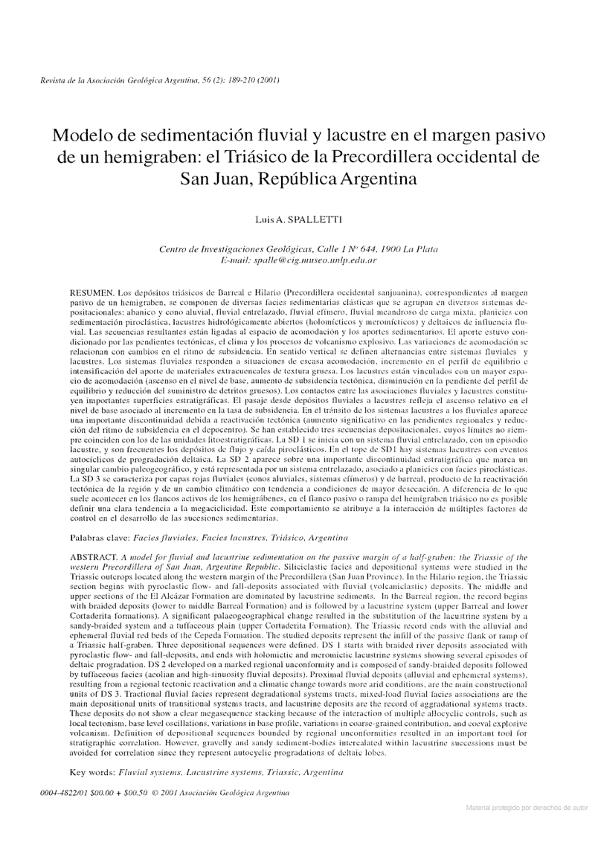Mostrar el registro sencillo del ítem
dc.contributor.author
Spalletti, Luis Antonio

dc.date.available
2019-05-09T21:01:00Z
dc.date.issued
2001-06
dc.identifier.citation
Spalletti, Luis Antonio; Modelo de sedimentación fluvial y lacustre en el margen pasivo de un hemigraben: el Triásico de la Precordillera occidental de San Juan, República Argentina; Asociación Geológica Argentina; Revista de la Asociación Geológica Argentina; 56; 2; 6-2001; 189-210
dc.identifier.issn
0004-4822
dc.identifier.uri
http://hdl.handle.net/11336/76006
dc.description.abstract
A model for fluvial and lacustrine sedimentation on the passive margin of a half-graben: the Triassic of the western Precordillera of San Juan, Argentine Republic. Siliciclastic facies and depositional systems are studied in the Triassic outcrops located along the western margin of the Precordillera (San Juan Province). In the Hilario region the Triassic section begins with pyroclastic flow- and fall-deposits associated with fluvial (volcaniclastic) deposits. The middle and upper sections of the El Alcázar Formation are dominated by lacustrine sediments. In the Barreal region the record begins with braided deposits (lower to middle Barreal Formation) and is followed by a lacustrine system (upper Barreal and lower Cortaderita formations). A significant palaeogeographic change produced the substitution of the lacustrine system by a sandy-braided system and a tuffaceous plain (upper Cortaderita Formation). The Triassic record ends with the alluvial and ephemeral fluvial red beds of the Cepeda Formation. The studied deposits represent the infill of the passive flank or ramp of a Triassic half-graben. Three depositional sequences were defined. DS 1 starts with braided river deposits associated with pyroclastic flow- and fall-deposits, and ends with holomictic and meromictic lacustrine systems showing several episodes of deltaic progradation. DS 2 develops on a marked regional unconformity and is composed of sandy-braided deposits followed by tuffaceous facies (aeolian and high-sinuosity fluvial deposits). Proximal fluvial deposits (alluvial and ephemeral systems), resulting from a regional tectonic reactivation and a climatic change towards more arid conditions, are the main building units of DS 3. Tractional fluvial facies represent degradational systems tracts, mixed-load fluvial facies associations are the main depositional units of transitional systems tracts, and lacustrine deposits are the record of aggradational systems tracts. These deposits do not show a clear megasequence stacking because of the interaction of multiple allocyclic controls, such as local tectonism, base level oscillations, variations in base profile, variations in coarse-grained contribution, and coeval explosive volcanism. Definition of depositional sequences bounded by regional unconformities resulted an important tool for stratigraphic correlation. However, gravelly and sandy sediment-bodies intercalated within lacustrine successions must be avoided for correlation since they represent autocyclic progradations of deltaic lobes.
dc.format
application/pdf
dc.language.iso
spa
dc.publisher
Asociación Geológica Argentina
dc.rights
info:eu-repo/semantics/openAccess
dc.rights.uri
https://creativecommons.org/licenses/by-nc/2.5/ar/
dc.subject
Facies Fluviales
dc.subject
Facies Lacustres
dc.subject
Triásico
dc.subject
Argentina
dc.subject.classification
Meteorología y Ciencias Atmosféricas

dc.subject.classification
Ciencias de la Tierra y relacionadas con el Medio Ambiente

dc.subject.classification
CIENCIAS NATURALES Y EXACTAS

dc.title
Modelo de sedimentación fluvial y lacustre en el margen pasivo de un hemigraben: el Triásico de la Precordillera occidental de San Juan, República Argentina
dc.title
A model for fluvial and lacustrine sedimentation on the passive margin of a half-graben: the Triassic of the western Precordillera of San Juan, Argentine Republic
dc.type
info:eu-repo/semantics/article
dc.type
info:ar-repo/semantics/artículo
dc.type
info:eu-repo/semantics/publishedVersion
dc.date.updated
2019-03-18T14:43:41Z
dc.identifier.eissn
1851-8249
dc.journal.volume
56
dc.journal.number
2
dc.journal.pagination
189-210
dc.journal.pais
Argentina

dc.journal.ciudad
Ciudad Autónoma de Buenos Aires
dc.description.fil
Fil: Spalletti, Luis Antonio. Consejo Nacional de Investigaciones Científicas y Técnicas. Centro Científico Tecnológico Conicet - La Plata. Centro de Investigaciones Geológicas. Universidad Nacional de La Plata. Facultad de Ciencias Naturales y Museo. Centro de Investigaciones Geológicas; Argentina
dc.journal.title
Revista de la Asociación Geológica Argentina
dc.relation.alternativeid
info:eu-repo/semantics/altIdentifier/url/http://www.scielo.org.ar/scielo.php?script=sci_serial&pid=0004-4822&lng=es&nrm=iso
Archivos asociados
